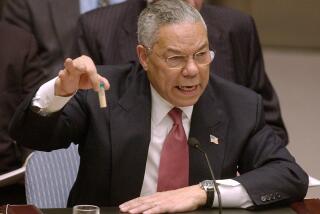Administration Eager to Tell Its Side of Summit
- Share via
WASHINGTON — Even as they flew back through the night from Reykjavik, President Reagan’s senior aides huddled in the cabin of Air Force One to decide how to counter quickly what they foresaw as a campaign by the Soviet Union’s “propaganda machine” to hold Reagan responsible for the collapse of the Iceland meeting.
Once back in Washington, they immediately launched a media blitz--one that still has news organizations reeling from “an information glut”--designed to shift blame for any stalemate to Soviet leader Mikhail S. Gorbachev and to portray the two-day session as a significant step forward in arms control negotiations.
Presented with headlines blaring such negative terms as “collapse” and “stalemate,” top officials saturated the television talk show circuit to present their side of the story. And, in a rare display of eagerness, White House aides telephoned news bureaus and offered to make available such high-ranking officials as Donald T. Regan, White House chief of staff, and John M. Poindexter, the national security adviser.
Usually Shuns Press
At a hastily arranged breakfast sponsored by the Christian Science Monitor, reporters expressed amazement at the presence of Poindexter, who has a widely known reputation for shunning the press.
“Periodically, on matters of great significance, when we have to talk to a lot of people in a short period of time, I obviously will have to pitch in and do my part,” Poindexter said.
After an early morning appearance on NBC’s “Today” show, Regan came to the Washington Bureau of The Times for breakfast, a session arranged at his request. He said the President himself “set the tone” for the White House media offensive.
“He said that ‘we’ve got to explain why we were so adamant and why we wouldn’t trade. . . . I think, when they understand it, they’ll agree with what I did.’ ”
When Air Force One left Iceland, Reagan and his top officials knew they were on the defensive in the propaganda war. The Soviets were portraying Reagan as the spoiler, the one who had broken off the talks because of his insistence on keeping his Strategic Defense Initiative, the space-based anti-missile program.
Began With TV Speech
Regan, Poindexter and White House spokesman Larry Speakes quickly decided that the only way to combat the Soviet public relations onslaught would be to mount a similar offensive of their own. And, by early indications, the Administration’s campaign to redefine the outcome of Reykjavik appears to be working.
The first salvo in the blitz was Reagan’s prime-time television speech Monday night, which resulted in headlines extolling “Summit Progress” and declaring that Gorbachev “Barred Accord in Arms Reduction.”
In the next phase of the media drive, top officials fanned out to television talk shows and newspaper editorial boards to reinforce Reagan’s optimistic assessment.
Secretary of State George P. Shultz’s 17-hour workday included a dawn appearance on the “CBS Morning News,” lunch with the Washington Post, an afternoon press conference, an appearance on CNN’s “Crossfire” program and a late-night interview on ABC’s “Nightline.”
Shultz also participated in a briefing at the White House for network anchors and columnists, where the star attraction was the President himself.
More to Read
Get the L.A. Times Politics newsletter
Deeply reported insights into legislation, politics and policy from Sacramento, Washington and beyond. In your inbox twice per week.
You may occasionally receive promotional content from the Los Angeles Times.









